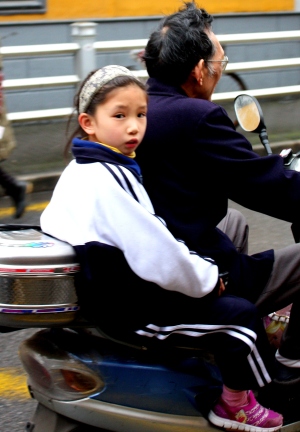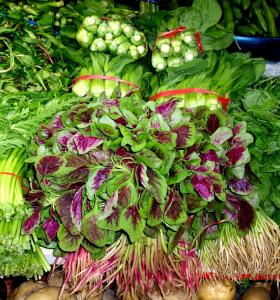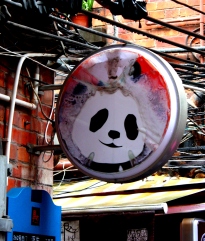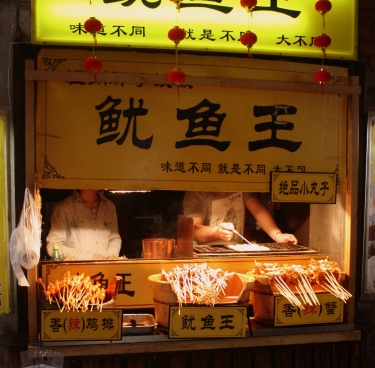
It’s common to see children carried on motorbikes.
Some of the best insights into other cultures come from watching what’s happening on their streets and from talking with those who live there.
Fortunately, English-subtitled street and store signs are common in Shanghai’s business and shopping districts, and around the most popular tourist attractions.
These streets are well-policed, and navigating the nearby neighborhoods requires no knowledge of Chinese for anyone with an English-labeled map and a modest sense of adventure.
English has been increasingly spoken here since the British occupied the treaty ports in the 1840’s. These days the American dialect is heard at least as commonly.

Seniors are particularly revered in China.
China promotes English literacy in its schools, but during my visit I met several Chinese whose English was impressively self-taught from books, audio, and movies.
Walking the streets of Shanghai makes it hard to doubt that there are far more English-speaking Chinese than vice-versa, or that more of China’s English-speaking foreigners live in Shanghai than anywhere but, perhaps, Hong Kong.

Smartphones and selfie sticks are everywhere.
Like most places I’ve visited, China has laws and customs which suggest themselves as practices worthy of adoption by others.
This is not to suggest that criticisms of China’s record on issues including human rights and carbon emissions should be ignored, but that there’s more to the Chinese story than the headlines of business and geo-politics can convey.
What I share here is drawn solely from personal observations and anecdotes told to me by locals.

Street vendor with whistles and friend await the next tourist bus.

Red shoes are wildly popular this year.
One apparent legacy of the Communist “bottom-up” ideology is the priority given to promoting quality of life for the Chinese masses.

Just hanging out.
In Shanghai, Beijing, and Zi’an I saw modern subway systems and robust bus networks. Some large cities are also linked by high speed rail and all three modes of transit are connected by shared stations.
Burgeoning motor traffic moves along modern expressways, but major surface streets in larger cities have dedicated cycle lanes which are often fenced off from car and truck lanes.
The many public parks were well-landscaped – often to a pleasingly Chinese aesthetic – and widely used. New high-rise apartments face generous green spaces.

Only families with twins, minorities, and only-child couples can have more than one child
China’s forests were depleted during the Mao era and the nation is a net importer of timber. Logging is restricted, and tree-planting is widespread.
I saw far fewer panhandlers both downtown and around tourist attractions than on the streets than in similarly-sized American or European cities. I can’t say the same for pickpockets; the same constant vigilance as elsewhere is a must while in China.
I was told that the government pays unemployment benefits, but only after exhausting all options to find work for applicants. Applications are first posted in the applicant’s local neighborhood to afford whistleblowers the opportunity to flag fraudulent claims.
Well under 10% of citizens are Communist Party members, and Chinese with whom I spoke seemed generally indifferent to domestic politics – other than the current campaign to root out corruption – as long as prosperity continues.
Chinese of all ages appeared fit and lean. Many working class Chinese still walk or ride bicycles or perform physical labor. Most apartment buildings built decades ago lack elevators, and it’s not uncommon for their residents to climb a half dozen flights of stairs.

Tourists from all over Asia also come to China.
The people also appeared to be well-fed. China’s often-maligned one-child policy averted a humanitarian disaster by reducing the number of mouths to be fed by more than three hundred million.
For Chinese aged thirty years or younger, the days of food shortages are at most a childhood memory.
Asians were among the earliest adopters of camera phones and smartphones. In China this technology brought phone and internet connectivity to a large segment of the population for the first time. Smartphones are pervasive both in China’s cities and countryside.

Waiting for the morning bus.
Camera phones feed a seeming addiction of the Chinese to picture-taking. There were plenty of selfie sticks in use at every tourist attraction.
Older Chinese frequently wave off photographers or shield their faces, but I was invited by younger people on dozens of occasions to co-star in their selfies.
It’s common in the U.S. to see people isolated from each other by texting or earbuds. In China, smartphone cameras seemed far more often to bring people together. Some cultural trivia: The Chinese attach great significance to lucky numbers, and cellphone numbers which contain them can sell for a premium price.

Born after Mao.
If Mao’s corpse was not embalmed for public viewing in Beijing, he would be turning over in his grave at the look of the new China.
China’s income gap seems to be widening less because workers’ wages are falling than because the new prosperity has created a middle and upper class. The rising tide seems to be lifting many boats.
On the streets of downtown Shanghai, well-to-do residents drive foreign or domestic luxury cars. The same fashions appear here as in designer boutiques of Milan and Paris, and along Fifth Avenue and Rodeo drive.

Smartphone always handy.
A few of China’s newly-rich have even undergone cosmetic surgery to ‘Westernize’ their features.
(Just as Westerners see Asian eyes as an icon of racial identity, Asians see Westerners’ noses… hence the Chinese slang, “Big Noses.”)
I heard also heard the word ”banana’ used as a slang label for Chinese (“yellow on the outside….”) who exchange their Asian identity for a Western one. Interesting how the language used by too such different cultures to talk about race is so similar.

Hanging out.

Another Asian tourist.
Firearms are not the only weapons which Chinese are forbidden to own, and penalties for violators are stiff.
China shares borders with Afghanistan, Pakistan Kyrgystan, and Tajikistan, and metal detectors at public sites clearly reflects a concern with terrorism.
Still, I saw little presence of armed soldiers or militarized police.
China has a mandatory death penalty for homicide, manslaughter, rape, robbery, arson, bombings, planting of toxic substances and trafficking in dangerous drugs.
All of this gave me pause for reflection on the difference between the way Americans and Chinese set their social priorities, and the way that they evaluate trade-off’s for each.
And it makes it easy to conclude that each has something to learn from the other.

Millenials.
Next up: “Shanghai’s Jade Buddha Temple”
See my earlier posts from “21 Days In China”:






































































































































